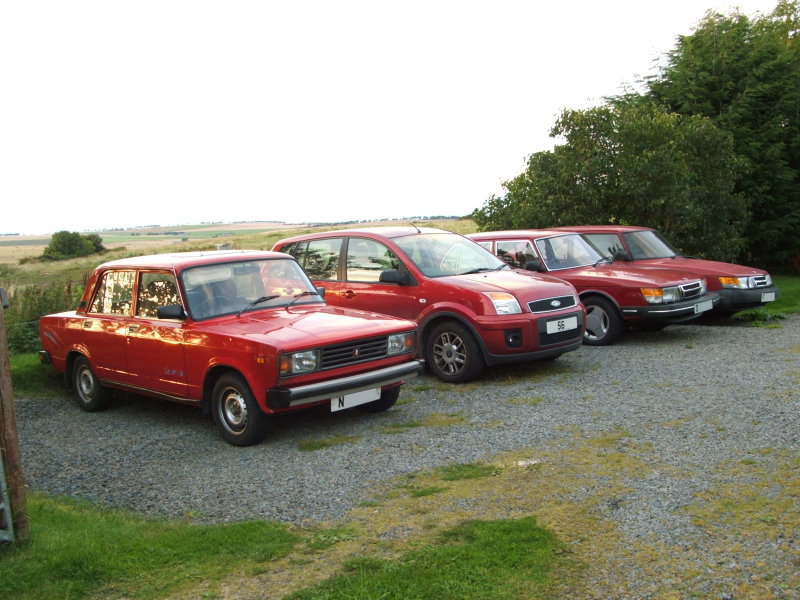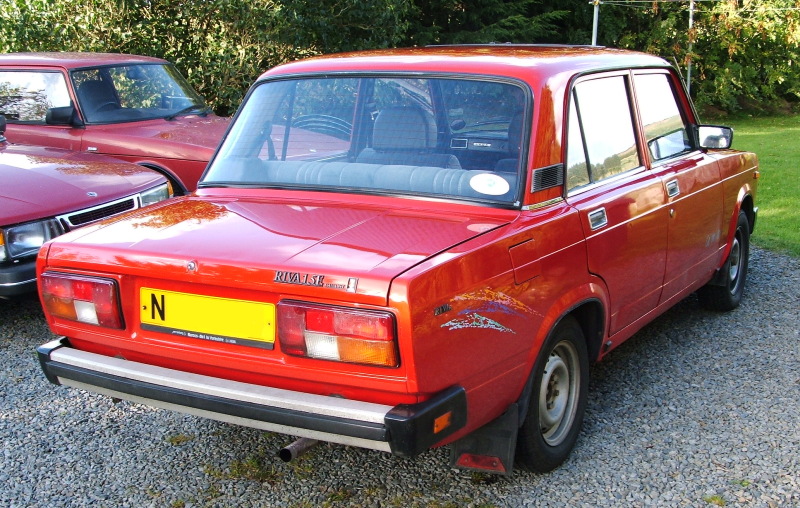
A car that the vast majority of people have heard of - and avoided like the plague! The treatment it's received from certain well known television presenters and the motoring press in general have done little to help this. I however couldn't care less what they think!
It's a car which I've had a bit of an obsession with since around five years of age, when I was a passenger in the back of my grandfathers white 1985 Riva 1300L. There was something which just appealed to me.
Now, as a driver, I've come to like the car even more. I really admire the complete honesty of the design. It really doesn't make any pretence to be something it's not. It's cheap, simple, fixable transport. It's that cheapness and simplicity which really appeal to me. You don't just point it in the direction you want to go and push a button - you actually have to DRIVE the car. A relaxed 100+ mph autobahn cruiser this is not! It really doesn't claim to be though.
Driving a Riva is a bit like stepping back in time some 20 (or some would say 30) years. They are not quick in standard trim, they are not refined, and they are incridibly noisy, and build quality is variable throughout - generally tending towards unacceptable...however they've just got this "feel" to them which it's quite impossible to describe, and makes driving the car quite an addictive experience. There's no half measures I think though - it's something you either love or hate. You also have to take into account that if you're getting out of a modern car and jumping into a Riva, you will probably become utterly convinced that it's trying to kill you for at least the first five miles.
Walking up to the car, you're greeted with a boxy shape which screams 1960s Fiat at you (if you're familiar with automotive miscellanea of that era anyway!) - this is quite right, as Lada bought the old Fiat 124 design from the Italians in the 70s, lock stock and production line. The Riva is basically a 124 with a nominal amount of restyling and a few mechanical tweaks - and made of much thicker (though no less rust prone) metal. The car pictured here was registered in 1995 - no, that's not a typo. You really could be forgiven, looking at the overall shape, the chrome and such that this was a 30 year old car.
It's worth noting that I'm presently in the process of tidying this car up - hence the silly reflectors attached to the bumper end caps, the mudflaps, the ill fitting drivers door, the cloudly tail lights and the missing rubbing strip (still present but hanging off on some photos) under the doors.
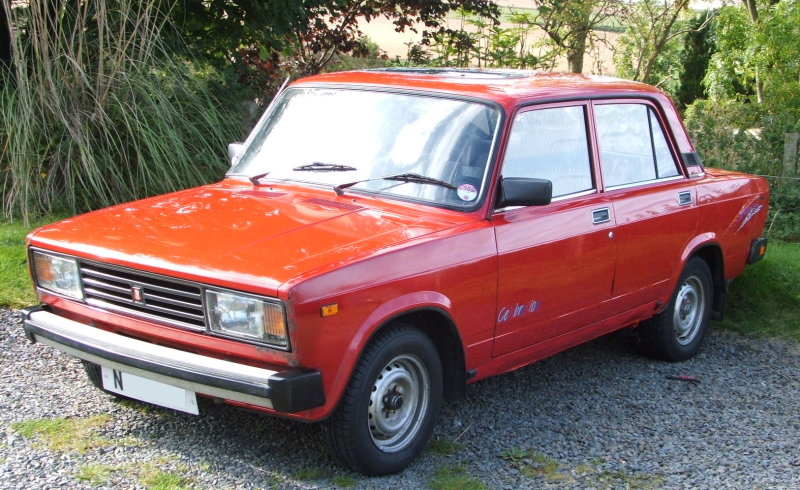
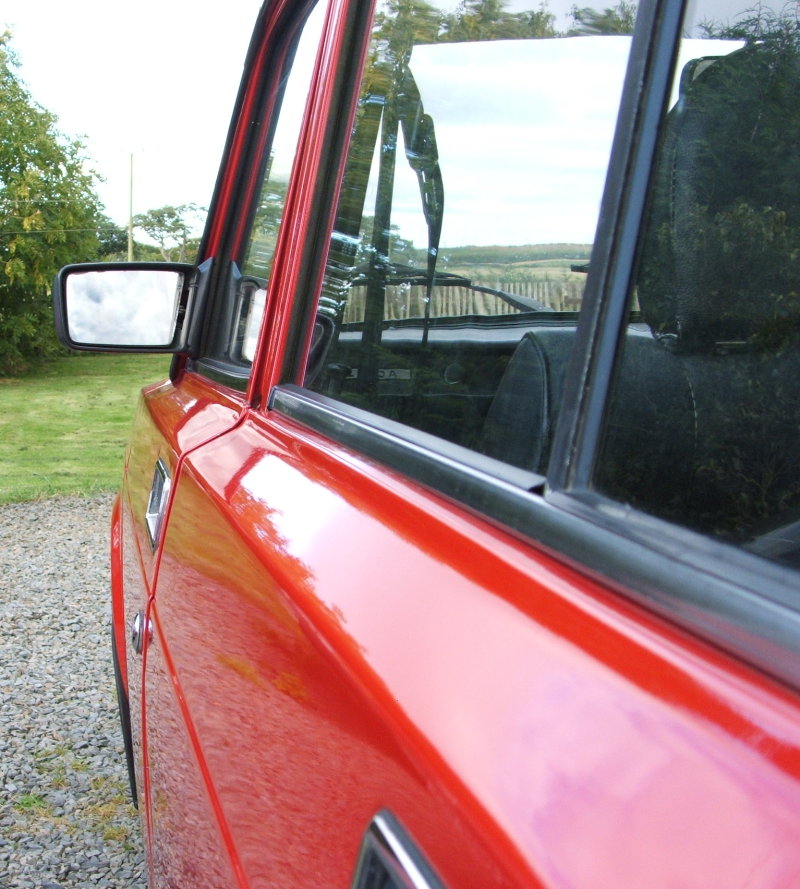
I personally think that the eye-searingly bright (the photos really do not do it jusitce - it is seriously bright!) red of my car suits it perfectly - though the estate variant I think looks best in white. The garish vinyls on the rear quarter and doors seemed to be a common feature on a number of Lada models. Some people have suggested I remove them - I've no intention of doing so however. They're part of the cars history, and I think fit its character well. This special edition - the Celebration (I THINK this related to the Riva's 10th birthday in the UK - imports having started in 1984), gave you a grand additional equipment list including a sunroof, radio/cassette player and...um...well...that's it! In the photo below, just above the green section, you can just about see what I assume is the design company or designer of the graphics name printed.


We're used to things like the door handle above being plastic - nope! The surround's chromed aluminium and the black bit is powder coated (I think) aluminium again. I discover this on a frequent basis when I walk up to the car and go to open the door only to have it zap me. Static is not my friend. I don't think there's really anything I can do about the pitting you can see there unfortunately.
Opening the door (which in itself makes an unnervingly loud tinny click when you pull the handle), and the 70s theme continues. A truly massive steering wheel which would seem more at home in a bus, a long thin gear lever sprouting from the floor at a rather odd angle, and an abundance of black (or beige on some cars) vinyl trim and shiny black plastic. The photos below are again of my car - the interior at least I don't need to do much with, it's cleaned up like new.
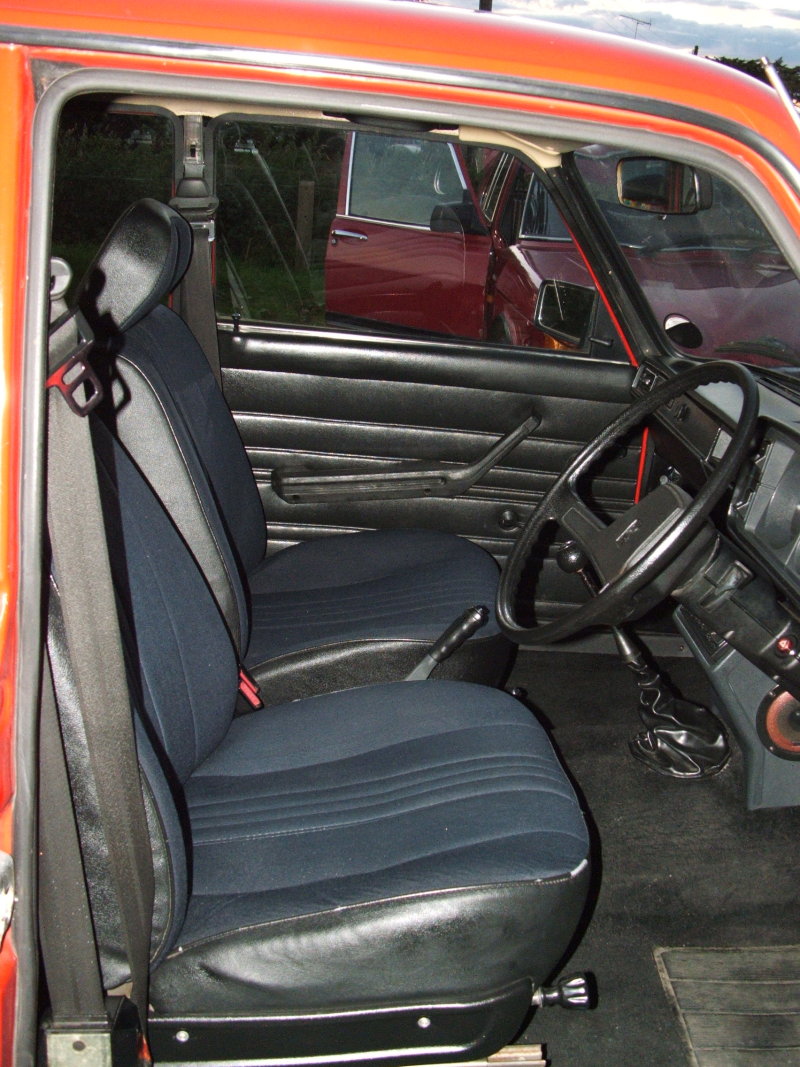
On the dashboard, the shiny black plastic theme continues, along with some huge chunky rocker switches, big chrome rimmed instruments, really fiddly (not to mention impossible to comprehend) heater controls and long spindly control stalks around the steering column. The ergonomics are actually surprisingly good - with all the controls you're ever going to need right at your fingertips around the instrument cluster. The long gear lever leaves itself conveniently close to the wheel too - making quick changes dead easy.
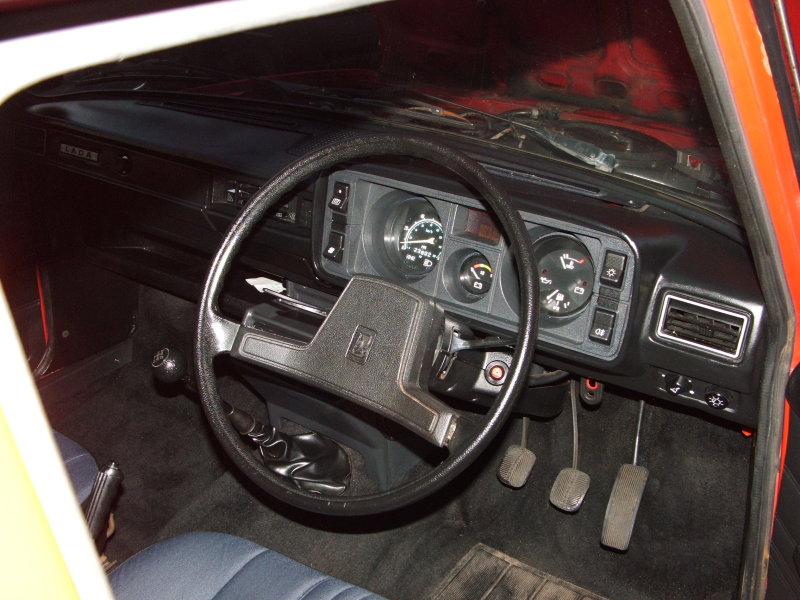
One of the points which really sticks in my mind as a driver about this car can be seen below. This is approximately what you see when in the drivers seat. The boxy shape, low dash and almost completely flat bonnet mean that you can really see exactly where the front of the car is.
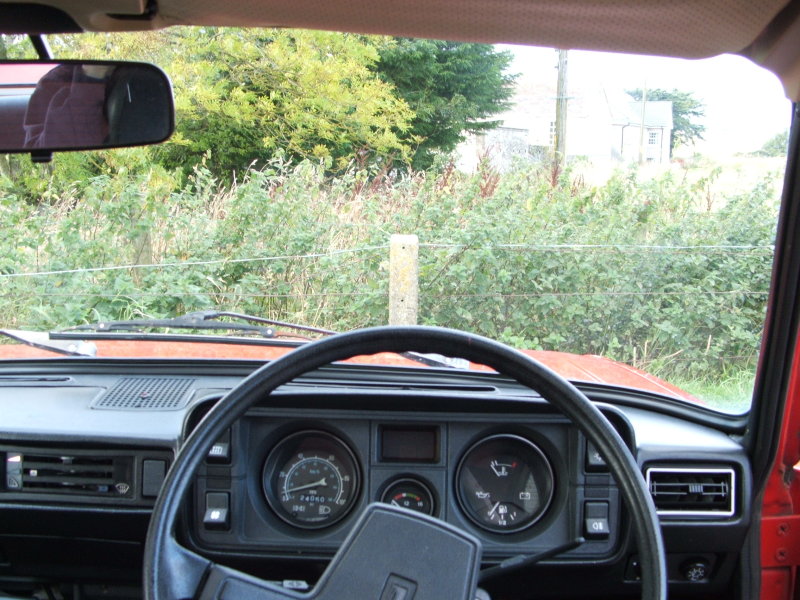
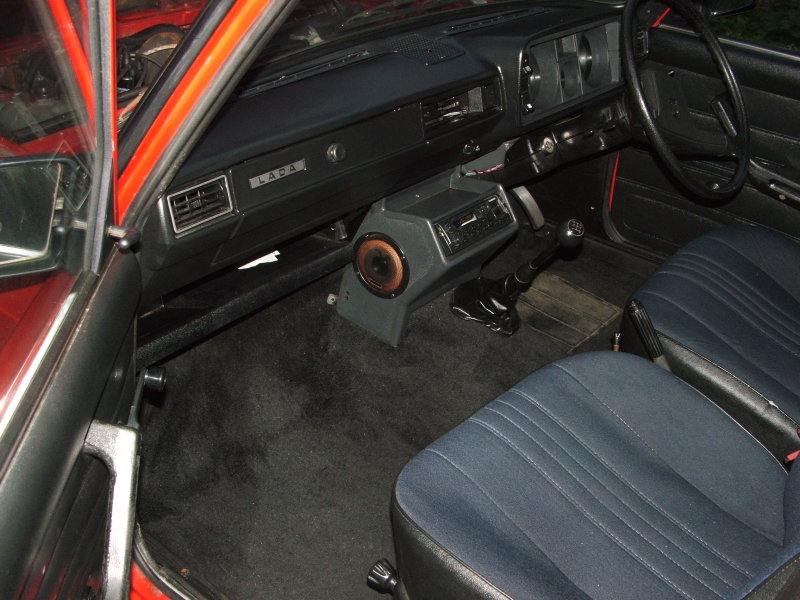
The speakers in the centre console on my car are certainly not standard, and haven't been encountered on any other Riva I've seen. The speakers seen there are also absolutely apalling! Sorting out the audio is on my to do list. You should never put anything thermally sensitive in the glove compartment by the way, as this area gets superheated by the supremely effective heater! The lack of door pockets do make this a bit of a nuisance, though at least there's a sizable shelf underneath it. The floor is far from flat, with a big hump where it goes over the gearbox and propshaft - this is afterall, a car with a classic in-line engine and rear drive setup.
Lada are great believers in the philisophy of "if it ain't broke, don't fix it." They also see no reason to stock two parts when one will do. This has resulted in the vast majority of parts having remained unchanged throughout the cars long production run (still coninuing in the home, Russian market to this day!), remaining the same, and in many cases being shared throughout the whole model range. The exceptions being some steering and suspension components which are specific to the right hand drive cars such as this one (right hand drive steering boxes for example are nigh on unobtainable new these days), and on post 1993 cars in the UK an electronically controlled carbburetor was fitted to allow a catalytic convertor to bring the car into line with the new emmission regulations. New Rivas are fitted with multipoint fuel injection - though this does preclude conversion to right hand drive - as the inlet manifold gets in the way of where you'd need the steering box to be. There was also a 1600SLX version, which was the "luxury version" - sort of like the Ghia version of some Fords. This had some bespoke chromework, a different bonnet and some interior changes, notably different front seats, centre console and instrument panel. These "Sixes" are they are sometimes known are especially rare on UK roads and are starting to become quite sought after. Personally though - I like the "original" look just the way it is. Though obviously...if a Riva Six appeared for sale on my doorstep, I'd have a hard time refusing it!
Rear seat passengers fare reasonably well in the Riva. While it's not exactly luxurious, and doesn't sport limosine levels of space, it isn't cramped, and the seats are actually surprisingly comfortable. There's a surprising amount of padding on them as well.
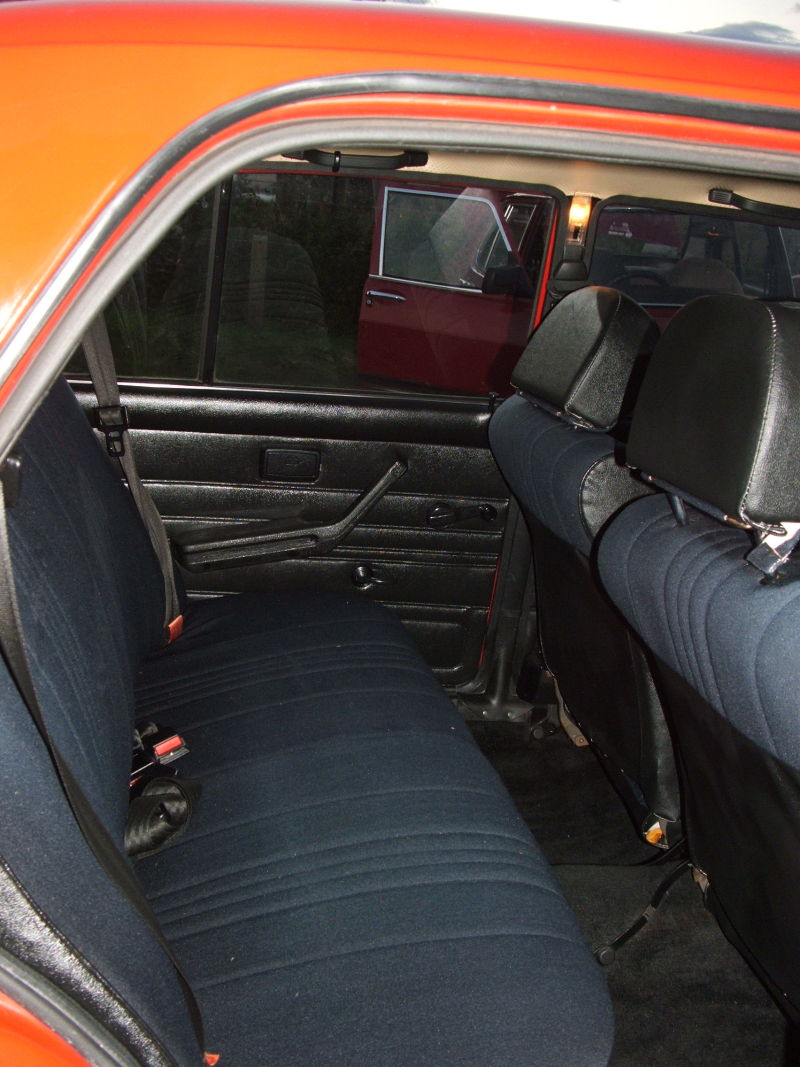
In both front and rear, one area this car excels in is provision of headroom. This is actually the reason my grandfather bought his Riva. He's a very tall gent, and tends to find it very hard to get a comfortable car.

In the boot, there's a surprising amount of space, given that the fuel tank is taking up a fair chunk of space on the drivers side, the spare wheel on the other, and a comprehensive toolkit which hangs on a couple of hooks between the tail lights. It's very deep for the most part, with a higher shelf towards the front where the floorpan goes over the back axle. One thing to watch with the boot of this car - it can only be opened with the door key - and if wrestling with heavy shopping, it's all too easy to put the keys down on top of the spare wheel or the fuel tank and slam it closed - if you do that, you're in trouble - so don't!
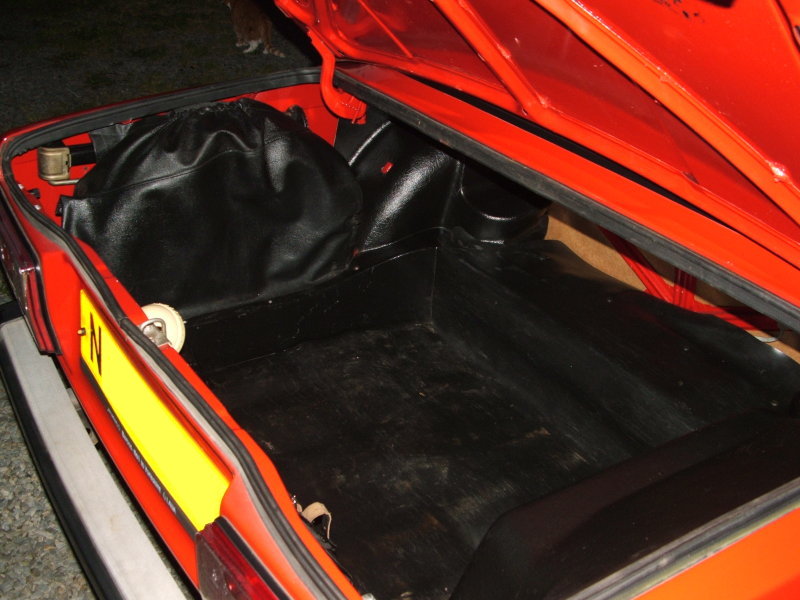
This is the point where I run out of current photos...so revert back to the ones from when I first got the car...so forgive the scruffy state of it!
Under the bonnet, anyone who knows a spanner from a screwdriver will be pleasently surprised with the simplicity of what they see. This car is propelled by a very conventional four cylinder in line, 8 valve overhead cam engine. The only real complication is that the later cars like this one gained a very complicated carbburetor (nicknamed by many owners the Horror or Devil Carb due to its complexity) and about ten miles of additional vacuum lines to deal with the emission control system. The fact of the matter is though, this system isn't all that dire when you break it down into its component parts - and all the diagrams you're likely to need are out there - just don't expect to find them in the Haynes manual - it doesn't cover the emission control systems fitted to the post 93 cars. The 1300 engine deserves a quick mention due to the fact that its timing gear is belt driven - wheras the 1200, 1500 and 1600 engines are all chain driven.
The photo below gives you a good idea of the layout of the engine bay. The air intake "horn" is missing in the photo below - I was trying to work out where half of my disconnected vacuum hoses were meant to be connected to (it's a wonder the car was running at all!), and it was getting in the way - so I took it off. It's worth noting that the washer bottle isn't original either - it appears to be a VW sourced replacement someone has cable-tied into place in the past at some point.
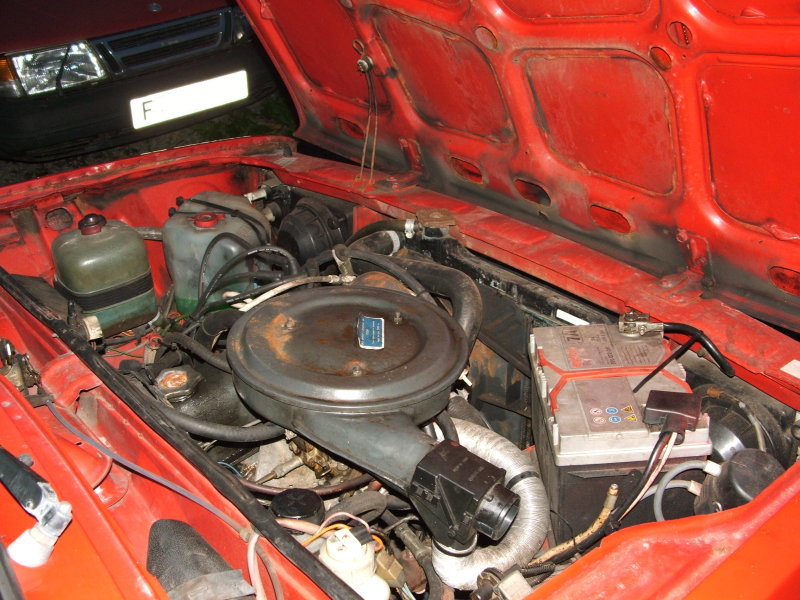
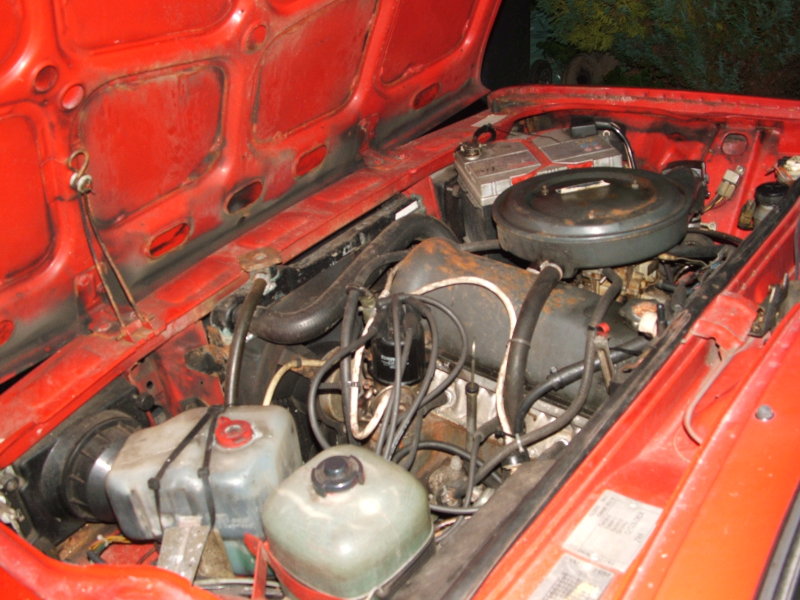
Two things are a pain to get to in this engine bay. The first is the filler plug for the steering box - buried on the right hand side down under the brake master cylinder. Getting to that requires a certain amount of contortion to get your hand in between that, the inlet and exhaust manifolds - I tell you from experience that trying to do this with a hot engine is a Very Bad Idea (TM). The second is, if you've got a big bottle of oil (i.e. when doing an oil change) is the oil filler. I strongly suggest that you either use a funnel or smaller bottles. If you don't, you'll probably end up spilling oil all over the timing cover like I did.
The very dirty looking white hoses you see crawling all over the engine bay are the vacuum hoses - these are silicone hoses and are actually quite durable - they do however discolour badly, hence the "dirty" appearance.
Driving the Riva is quite an experience. The first thing people usually comment on is the steering, which compared to any modern car is incredibly heavy, especially when travelling at low speeds. This makes parallel parking really quite a challenge. You do get used to it quickly though, and it certainly doesn't bother me in day-to-day driving to be honest.
Closely followed by that, is usually the brakes - usually accompanied by the car lurching to a halt a few milliseconds later. The pedal in the Riva is quite heavy - requiring a moderate push to bring about braking, but they definitely do work well enough - locking all four wheels is quite possible if you really stamp on the pedal. Don't expect ABS, EBA or anything else like that though! Stamping on the pedal is what most people tend to do after pressing the pedal a tiny bit and finding nothing happening - this causes the nose of the Riva to dive towards the tarmac in quite a comical manner.
The clutch is actually very civilised, it's not too heavy and not horribly light (I keep thinking I've broken the clutch in my fathers 2006 Ford Fusion as there's no resistance on the pedal at all!). It does pretty much exactly what you tell it to - not much else to say here really! My car is prone to a little clutch judder sometimes - I've identified this to be due to some somewhat soggy engine mounts though, nothing to do with the clutch.
The gearchange, in my view is the ace up the car's sleeve in driving terms. You look at that long, spindly lever and expect to have to move it from Wick to Cornwall going from first to second - wheras in fact, the throw is incredibly short, light and precise. You really can change gears in this car very quickly with a flick of the wrist. This is down to the layout of the drivetrain - the gear lever you move is connected straight into the box - no linkages or cables involved. The does mean that if you miss a gear though or if it kicks back out thanks to the idiot in the drivers seat getting it wrong, that you'll not be feeling your fingers for a few minutes!
On the subject of the gearbox, there is some debate over whether GL5 specified oils are safe for use with this gearbox - as a result, I'd tend to use mineral based GL4 oils if possible. GL5 IS safe IF the standard 2105E is also complied with - the label on the bottle should tell you that. If that's not mentioned, I'd probably avoid the oil. This is due to (it appears) a change in the specification of GL5 over the years - and potentials for problems with gearboxes including so called yellow metals - such as that in the Riva and Niva. This has been a subject of quite some debate, and I'm of the opinion that it can't hurt to play it safe.
The drivetrain itself is somewhat prone to being a bit jerky at low speeds, low gearing and a very sensitive throttle see to that! If you're paying attention though, it's quite possible to drive the car as smoothly as any other.
The ride is actually quite pleasant I find. It is a little bouncy - but not uncomfortably so, and it doesn't feel "fidgety" as some other cars I've had tended to. The suspension is fantastic at absorbing potholes and other flaws in the road which tended to knock the fillings from my teeth in the Saab. You notice this by far the most when driving around town, where the effectiveness of the suspension really does shine. Also in town, you note as well the fantastic gearchange and visibility which I don't think any modern car can rival. The low gearing makes it surprisingly quick up to 30 or 40 as well, handy around town.
Out on the open road it fares less well, I shall confess. The Riva was designed when the world tended to take driving at a somewhat more relaxed pace, and as a result, it's geared in such a way that 60 and 70mph cruising involves a huge amount of mechanical noise. In my car, there's also quite a whine from the back axle at this speed - though I think that might just be my car! There's also a huge amount of wind noise - not surprising, really given that the car does have the aerodynamic profile of a brick. It also, thanks to a fairly low power output and not inconsiderable kerb weight, struggles a bit in acceleration terms.
Put such negative thoughts out of your head though, turn off the motorway, and go for a cruise down the country route though, and you'll find you've much more of a smile on your face though.
Things have changed - While the media still give Lada a hard time - peoples opinions in general have started to change. This is a car people compliment you on now, rather than laugh at you (though the odd person still does that too!). This is probably not least because it actually looks a bit distinctive...and that people can't remember the last time they saw one. I'm looking forward greatly to taking this Riva to its first classic car show next year, and to see what reception it gets.
There's some work to be done first though!
The photos below show the car as I picked it up.
Any sane person would have walked away...but I'm not sane. I will also admit...I felt sorry for it.
Oh dear...I have some work to do.
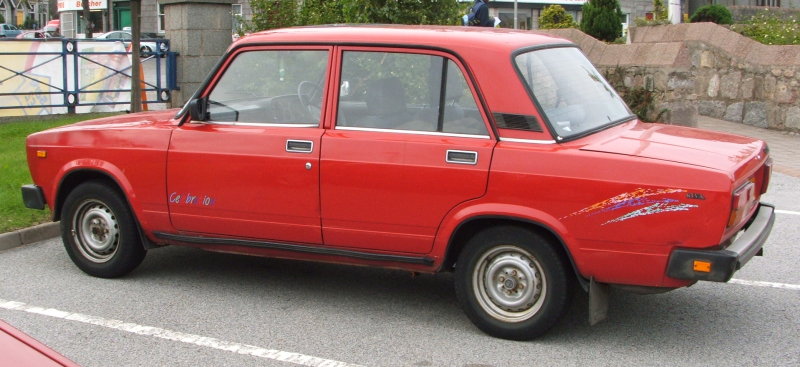
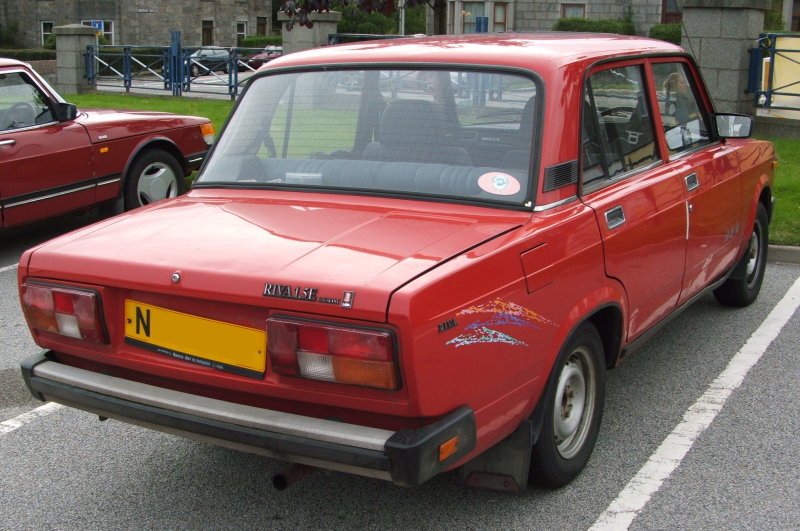
The rear registration plate hanging off really did round off the comedy Lada look quite well...
Lada front wings rust - this is one of the facts of life. Those on this are no exception. I'm going to have a shot at saving them though - purely to pracice my bodywork repair skills as much as anything else.
What does make this rust a bit puzzling is the fact that the car is fitted with wheel arch liners. Rivas normally rust out here as mud tends to collect in the corner of the wing, resulting in a nice little water trap which never dries out. The arch liners should have stopped this happening! Of course - I have no idea whether they were on the car when it was new. A large amount of rust treatment, some steel mesh, filler, and red paint later, and at least there are no sharp edges there. I'll be dealing with this properly once the car has a new MOT - for now however the rust should be kept at bay. The wing will have to come off to deal with rust on the inner wing behind the headlight anyway (they alway rust there too!).
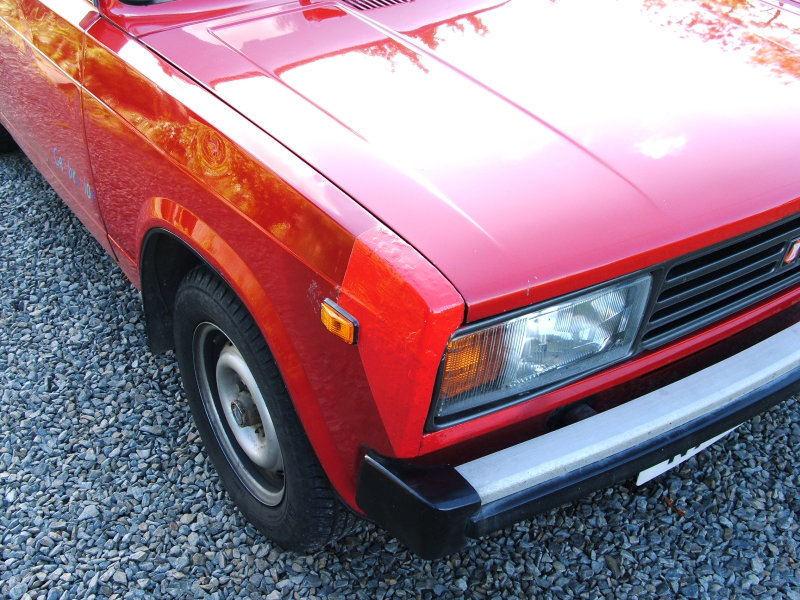
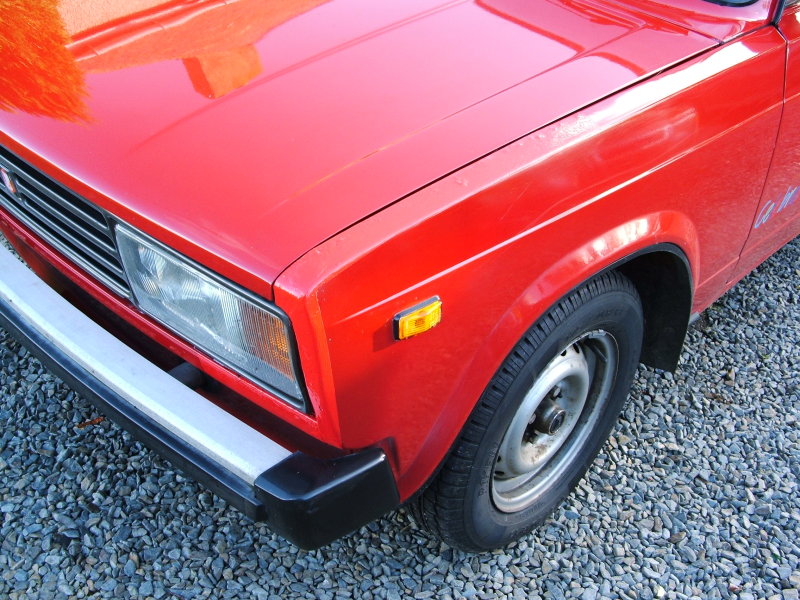
Celebration the graphics say...A celebration of rust it appears! That pile of iron oxide used to be most of my nearside chassis outrigger. Oh dear...looks like we may have a little welding to do.

Can I revise that estimate? Looks like we have a LOT of welding to do! This is the point at which most people would just have scrapped the car - but I've decided that with the assistance of my friend who is a genius with a MIG welder, that I'm going to keep at it.

That whole region is looking rather more healthy now (the tiny hole in the outer sill only appearing when the floor was finished!). All that remains now is for the remains of the old outrigger to be cut out, and the new one to be welded on, and for a new "cap" to be formed over the end of the sill section itself. Bad weather and a busy schedule have prevented this from being completed to date - the car is presently locked up in a friends garage patiently waiting to be finished.
Still need to address a somewhat less serious - but infinitely more awkward to get to bit of rust at the back of the sill on the driver side. The photo below shows the visible damage outside after a start was made cleaning it up ready for welding. Reconstructing the panel behind there is a bit fiddly to get to - we're hoping that getting the car up on ramps will make things at least a bit more user-friendly in that regard.
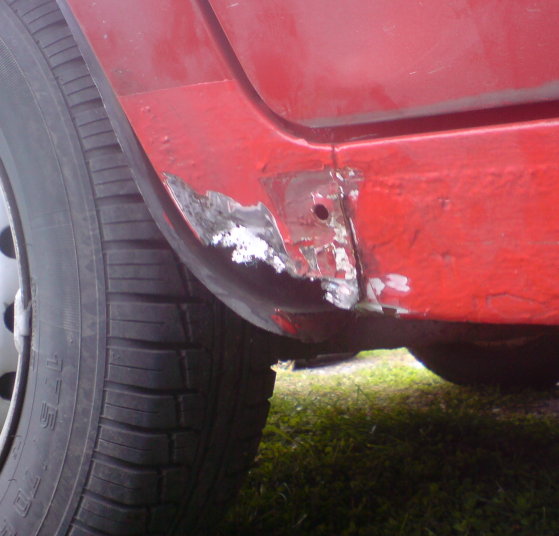
For now, a random selection of other photos until the car's back on the road...
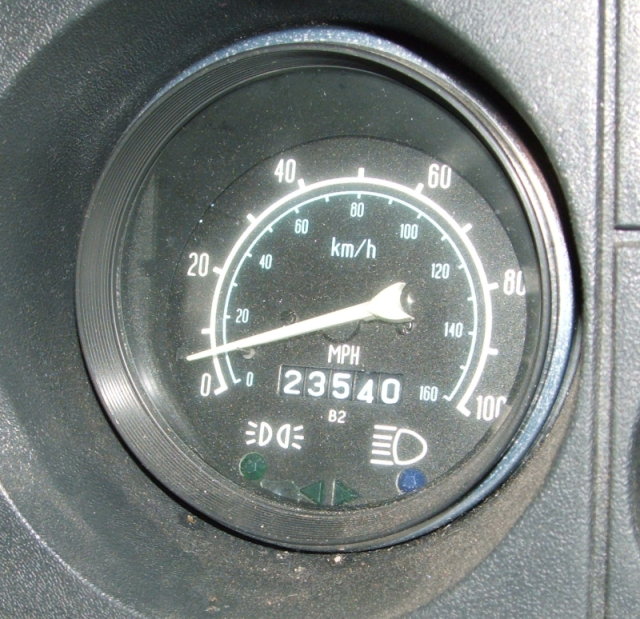
Another one from when I picked the car up - so forgive the grime. The deeply recessed, chrome rimmed instruments are one of my favorite features of the interior. The little "crystal" style warning lights are totally at odds with the 1995 year of production, and in addition look really rather pretty when lit I think. Though the main beam one is utterly useless for telling you if you've left it switched on in daylight as it's so dim!
A random somewhat arty shot along the side. This one's my favourite for the "What car is this?" question. The answer I usually get back is Volvo 240. I think it's the "shelf" at the top of the doors which fools people.
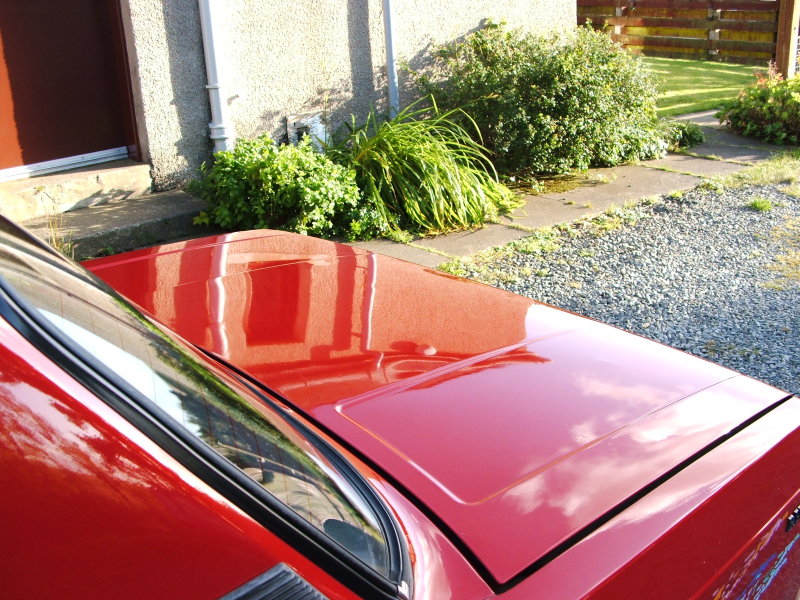
My experience has always been that red cars fade terribly, and tend to end up looking very matt in short order. This one seems to have resisted that very well.. This gives a rough idea how much of a shine came up on the paint following what was a very quick polish.

I'm not 100% sure whether this is a replacement from a 1600SLX (where the switches are down by the gear lever - the other way around) - or if it's Lada just deciding to only stock one switch. Yes...the rear window demister switch is upside down. It's also the only illuminated switch in the car...the light on the switch comes on when the headlights are on...doesn't have anything to do with the rear window heater being on or not, which has its own warning light on the instrument panel.

These days, you get a locking wheel nut key, a jack and a wheel brace if you're lucky. This is what you got in the Riva! That is the STANDARD tool kit! Hats off to them for providing the allan key for the sump plugs too!
I swore after getting the second faded red Saab and badly faded red Skoda that I'd never have another red car. Um...I seem to have failed, judging from the photo below! Worth noting as well that the Ford Fusion (for those of you in the United States - that thing in the middle, is a Ford Fusion - what you know as the Fusion is the Mondeo over here - just to confuse matters!) isn't actually mine! I've not suddenly got sensible! It IS however a very versatile beast, which I am very glad to have access to sometimes!
